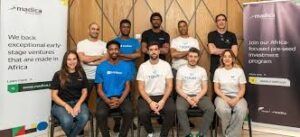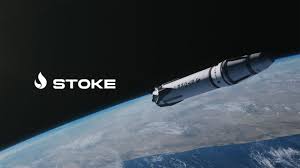Washington-based rocket manufacturer Stoke Space is raising $500 million at nearly $2 billion valuation—double its prior $944 million valuation from earlier Series C—led by Thomas Tull’s United States Innovative Technology Fund (USIT), despite having never reached orbit or generated launch revenue.
The round would bring total capital raised to approximately $1 billion from investors including Bill Gates’ Breakthrough Energy Ventures, Industrious Ventures, and Y Combinator. The company closed a $260 million Series C earlier in 2025.
Founded in 2019 by former Blue Origin engineers Andy Lapsa and Tom Feldman, Stoke Space is developing Nova—a fully reusable two-stage medium-lift rocket targeting 2-20 ton payloads to low Earth orbit, positioned between Rocket Lab’s Electron (small-lift) and SpaceX’s Starship (heavy-lift).
Stoke’s $2 billion valuation without operational launches relies on strategic validation rather than revenue traction. In March 2025, the US Space Force added Stoke to its approved launch provider roster—extraordinary for pre-launch startup and indicating government confidence in technical capabilities and program timeline.
Space Force approval provides access to National Security Space Launch contracts worth billions annually. Traditional aerospace primes (ULA, SpaceX) dominated this market, but DoD diversification strategy creates opportunities for emerging launch providers demonstrating reliability and capacity.
The company completed short-hop tests of prototype upper stage in 2022, validating liquid-cooled heat shield technology enabling re-entry survival. First-stage booster nearing completion positions Nova for inaugural test flight in 2026. These technical milestones reduce execution risk justifying higher valuations than purely conceptual ventures.
Stoke’s core technical bet centers on complete vehicle reusability including upper stage—capability only SpaceX approaches with Starship development. Existing reusable rockets (SpaceX Falcon 9, Rocket Lab Electron) recover first stages but discard upper stages after each flight.
Upper stage reusability matters economically because these components represent 30-40% of total vehicle cost. Reusing both stages could reduce launch costs by 50-70% versus partially reusable systems, creating margin advantages or enabling aggressive pricing capturing market share.
The liquid-cooled heat shield technology addresses upper stage re-entry challenges. Traditional ablative heat shields burn away during re-entry requiring replacement after single use. Liquid cooling systems using propellant circulation could enable multiple flights without refurbishment—similar to aircraft between flights rather than rockets requiring extensive post-flight rebuild.
Stoke targets 2-20 ton payload capacity occupying market space between Rocket Lab Electron (300kg) and SpaceX Falcon 9 (22 tons). This positioning addresses satellite constellation operators requiring frequent launches with moderate payload masses.
Starlink, OneWeb, and emerging constellation operators historically used Falcon 9 rideshare missions combining multiple small satellites per launch. However, rideshare requires coordinating schedules across customers and accepting secondary payload status. Dedicated medium-lift launches provide schedule control and optimal orbital insertion.
The market sizing depends on satellite deployment pace. Analysts project 10,000+ satellites launching annually through 2030 for communication constellations, Earth observation, and military applications. If even 20% require dedicated medium-lift launches, the addressable market exceeds 2,000 launches annually—sufficient to support multiple competing launch providers.
Stoke operates 168,000-square-foot Kent, Washington headquarters (near Blue Origin), 75-acre Moses Lake test facility, and constructs Cape Canaveral launch site. This infrastructure investment enables in-house engine development, vehicle manufacturing, testing, and launch operations without subcontractor dependencies.
Vertical integration creates several advantages: faster iteration cycles without external vendor coordination, intellectual property protection through reduced supplier access to proprietary designs, margin capture across value chain rather than paying supplier markups, and quality control maintaining standards throughout production.
However, capital intensity increases substantially. SpaceX spent over $1 billion developing Falcon 9 and establishing operational infrastructure. Stoke’s $1 billion total funding provides similar scale but compresses timeline—SpaceX developed Falcon 9 over nearly a decade while Stoke targets operational status within 7 years of founding.
USIT’s lead position (Thomas Tull’s fund focusing on defense and national security technology) aligns with Stoke’s Space Force approval. USIT portfolio companies typically serve government customers, suggesting expectation that Stoke’s primary revenue will derive from defense launches rather than commercial satellite operators.
Bill Gates’ Breakthrough Energy Ventures participation indicates climate angle beyond typical aerospace investment. Fully reusable rockets reduce manufacturing waste and enable higher flight rates without producing discarded hardware—environmental benefits complementing economic advantages.
Y Combinator’s involvement (Stoke participated in YC batch) validates the startup approach to aerospace traditionally dominated by established primes and well-funded unicorns like SpaceX and Relativity Space. YC rarely backs capital-intensive hardware companies, suggesting conviction in Stoke’s technical team and execution capabilities.
SpaceX dominates the launch market with 80%+ global market share through Falcon 9 and emerging Starship. Rocket Lab operates Electron for small payloads and develops larger Neutron targeting medium-lift markets. Relativity Space (raised $1.3 billion) develops 3D-printed Terran R. Firefly Aerospace (raised $300+ million) offers Alpha for small-lift and develops MLV for medium-lift.
Stoke differentiates through upper stage reusability emphasis while competitors focus on first-stage recovery or expendable systems. If the technical approach succeeds, cost advantages could enable undercutting competitor pricing while maintaining margins.
However, the launch market exhibits network effects favoring incumbents. SpaceX’s flight heritage, proven reliability, and existing customer relationships create high switching costs. New entrants must not only achieve technical success but also convince customers to accept unproven vehicles for expensive payloads.
Raising $500 million less than one year after $260 million Series C indicates high burn rate supporting infrastructure development, hardware manufacturing, and test campaigns. Rocket development typically costs $500 million to $2 billion from concept to operational status depending on complexity and vehicle class.
Stoke’s $1 billion total funding positions the company for multiple test flights and infrastructure completion but may require additional capital before achieving profitability. Launch revenue doesn’t typically cover development costs until companies demonstrate reliability through 10-20 successful missions.
The funding timeline suggests investors accept extended capital deployment before revenue generation—acceptable in aerospace where development timelines span 5-10 years but different from software ventures expected to reach profitability within 3-5 years of founding.
The 2026 first test flight target provides a near-term validation milestone. Success requires first-stage booster completion, upper stage integration, propulsion system qualification, and range safety approval from FAA and Space Force.
Even after successful first flight, commercial operations require multiple demonstrations proving reliability before customers entrust expensive payloads. SpaceX conducted 20+ Falcon 1 and early Falcon 9 flights before securing major commercial contracts. Stoke must anticipate a similar validation period.
The Space Force approval accelerates this process for government missions. Military customers accept higher risk than commercial operators for strategic capability access, providing early revenue while building flight heritage for the commercial market.
Investment Thesis Risks
Several factors could prevent Stoke achieving projected returns:
Technical failure: Upper stage reusability remains unproven. Heat shield failure or propulsion issues could require design changes extending the timeline and consuming additional capital.
Market saturation: If SpaceX achieves full Starship reusability, excess capacity could depress pricing eliminating margin advantages for competitors.
Regulatory delays: FAA environmental reviews and launch licensing can extend timelines by years, as experienced by SpaceX with Starship.
Customer adoption: Even with technical success, converting customers from proven providers to new entrants requires aggressive pricing or capabilities incumbents cannot match.
For investors at $2 billion valuation, exit requires achieving $4-6 billion valuation (2-3x return) through IPO or strategic acquisition. This necessitates demonstrating operational launch capability, capturing meaningful market share, and maintaining technology advantages over SpaceX and other competitors—challenging requirements for pre-revenue startup in capital-intensive industry.








